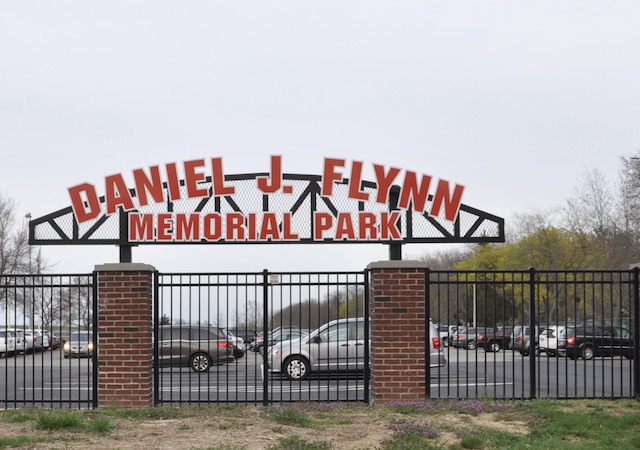
By Bradley Harris
Legend has it that Richard Smythe rode a bull on a jaunt around the boundaries of Smithtown when he staked out his claim to the land. To ride this bull a distance of some 35 miles through an untracked wilderness, in one day’s time, would have required a superhuman effort on the part of Richard Smythe, to say nothing of what would have been required of the bull. The most ardent supporters of the legendary ride look for ways in which Richard Smythe could have accomplished such a superhuman feat. Some say Richard Smythe wisely chose the longest day of the year, carefully plotted his course, trained his bull, built up his endurance and then made his mad dash. But the legendary account never provides an explanation of how ownership of the land passed from the Nesaquakes to Richard Smythe. For that explanation one has to look at the historical record.
The historical record of deeds and conveyances involving the Nesaquake lands show that Richard Smythe went through an involved and protracted struggle to legally acquire the land that is Smithtown today. His struggle began when he approached Lyon Gardiner about buying land that Gardiner had been given by the Montauk Chieftain Wyandanch. That land was owned by the Nesaquake Indians who lived along both banks of the Nissequogue River. Sometime in 1663, Richard Smythe got a conveyance for the Nesaquake lands along the Nissequogue River from Lyon Gardiner. Unfortunately we don’t know what this deed said because the deed has been lost. But we do know how Lyon Gardiner came into the possession of the Smithtown lands.
Lyon Gardiner of Gardiner’s Island fame, was the first Englishman to settle on eastern Long Island in 1639, and he was given the lands along the river as a gift from the Montauk chieftain Wyandanch. As the chief or sachem of the Montauks, the largest tribe of Indians on Long Island, Wyandanch was recognized as “the acknowledged ruler of all other sachems on the east end of Long Island. All the smaller tribes paid tribute to him, and it was generally understood that no conveyance of land was valid without his concurrence. In many instances, he held title to the lands by gift or purchase from the subordinate chief, and conveyed those lands to whites in his own name.” In 1659, Wyandanch did this with the Nesaquake lands when he presented them to Gardiner as a gift. Why he chose to do this is interesting. (William S. Pelletreau, A History of Long Island, New York: The Lewis Publishing Company, 1903, p. 200.)
According to William Pelletreau, after settling on Gardiner’s Island in 1639, Lyon Gardiner had been a friend to Wyandanch and the Montauks and had served as a “counselor in all their troubles.” (Pelletreau, op.cit., p. 201.) One of the troubles that the Montauk tribe encountered happened in 1653 when Narragansett Indians paddled across Long Island Sound in their war canoes to attack the Montauks. The Montauks were celebrating the marriage of Wyandanch’s daughter, Princess Momone – the “Heather Flower” – to a Shinnecock Indian chief and were not prepared for the vicious attack that followed. In the ensuing battle that took place in “Massacre Valley” in the hills north of Fort Pond Bay in Montauk, half the Montauk tribe, estimated to have been about 1000 Indians, were killed and Wyandance’s daughter, the “Heather Flower,” was kidnapped and taken across the Sound. Wyandance sought Lyon Gardiner’s help in getting his daughter back from the Narragansett Indians.
Lyon Gardiner appealed to the “British to pressure the Narragansetts into returning the Princess Momone. The Narragansett chief ‘Ninigret’ agreed to release the Heather Flower … in exchange for a huge pile of wampum.” Lyon Gardiner helped Wyandance gather the required wampum. (Barbara Marhoefer, Witches, Whales, Petticoats, and Sails, Port Washington, New York: Ira J. Friedman Division of Kennikat Press, 1971, pgs. 7-9.) The “ransom was sent to Ninigret in Montauk war canoes” only to be intercepted by agents of John Winthrop, governor of the Connecticut colonies.” Again Wyandanch appealed to Lyon Gardiner to intercede on his behalf and Lyon “intervened with Winthrop” who “saw to it that the wampum was delivered to Ninigret.” (Barbara Marhoefer, op. cit., pgs. 7-9.) The Heather Flower was finally released by Ninigret and “tradition has it that the restoration of Wyandanch’s daughter to her father … took place at “Richard Smythe’s residence at Setauket.” (Frederick Kinsman Smith, The Family of Richard Smith of Smithtown, L.I., Smithtown, New York: Smithtown Historical Society, 1967, p. 21.)
A grateful father and sachem then decided to give Lyon Gardiner a token of his appreciation for all that Lyon Gardiner had done for him. At East Hampton on July 14, 1659, in a very unique deed called the “deed of friendship” that has a unique drawing of two stick figures shaking hands, Wyandanch conveyed the Nesaquake lands along the Nissequogue River to Lyon Gardiner. What is interesting about this particular deed is that Richard Smythe’s name appears on this document as a witness to the deed. And four years later, Lyon Gardiner sold these very same lands to Richard Smythe.
The question that arises is whether Richard Smythe’s interest in the Nesaquake lands was awakened by his witnessing the signing of this deed or whether “he may have had something to do with bringing about the transaction” in the first place. (Frederick Kinsman Smith, op. cit., pg. 11.) William Pelletreau felt that there was “little doubt but that the whole affair had been prearranged between Gardiner and Smith.” (Pelletreau, A History of Long Island, op. cit., p. 201.)
So it would seem that Richard Smythe may have been the instigator of the famous “deed of friendship” between Wyandanch and Lyon Gardiner and that his interest in the whole affair was to gain title to the Nesaquake lands from Lyon Gardiner. When the Nesaquake lands were conveyed to Richard Smythe by Lyon Gardiner in 1663, Richard Smythe set about securing undisputed possession of the land. This was to take him the next 12 years of his life. More about Richard Smythe’s struggle to secure the Nesaquake lands as his own next time….
 Monday, May 31, 2010 at 9:52PM
Monday, May 31, 2010 at 9:52PM 









